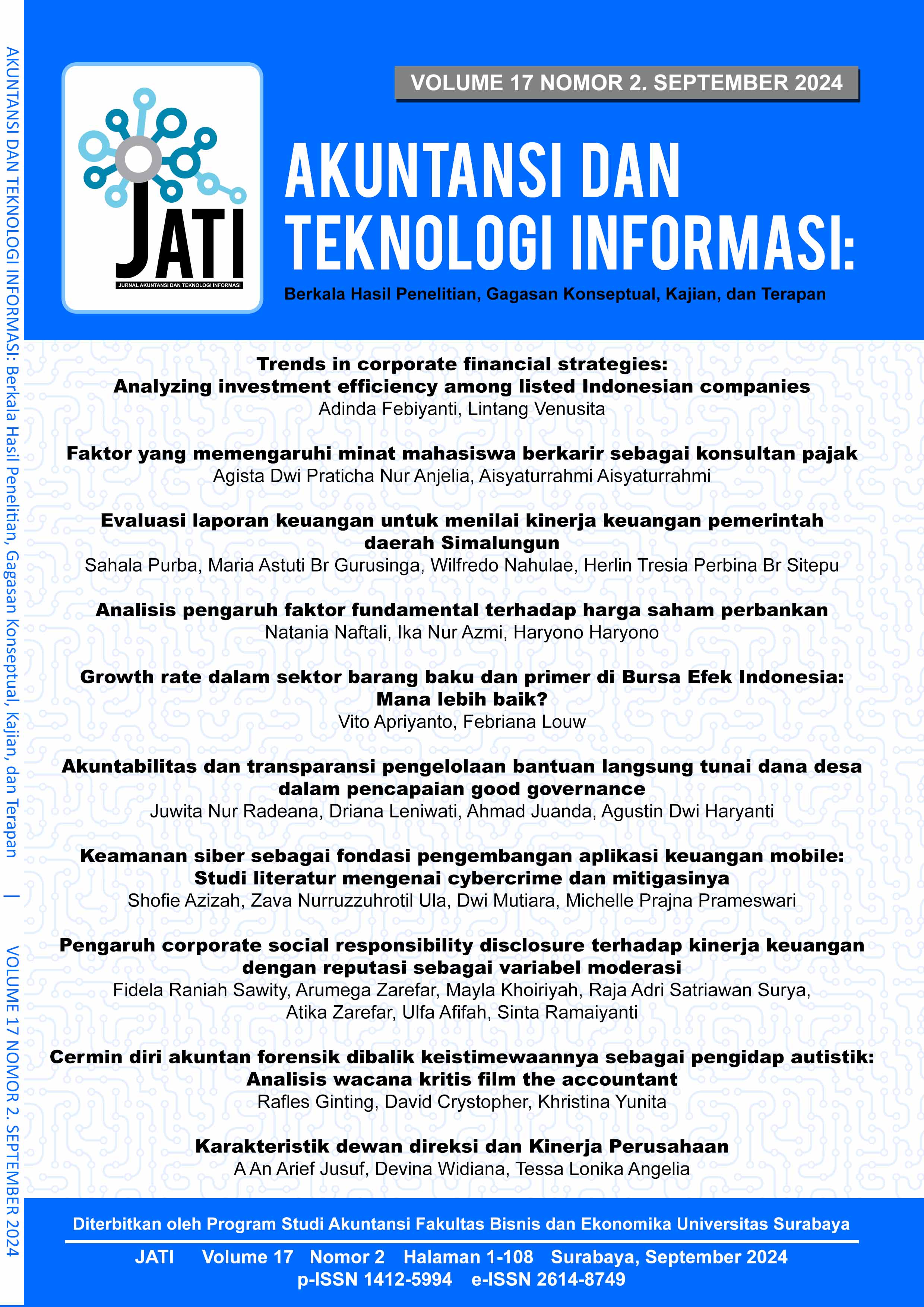Growth rate dalam sektor barang baku dan primer di Bursa Efek Indonesia: Mana lebih baik?
 Abstract Views:
393 times
Abstract Views:
393 times
 PDF Downloads:
272 times
PDF Downloads:
272 times
Abstract
The Sustainable Growth Rate is the maximum growth rate of a company so that it can grow without running out of funds from funding activities such as increasing shareholder capital ownership and drawing loans from creditors. This study measured, tested, and analyzed factors affecting sustainable growth. Some of the factors used in this study are leverage, profitability, and total asset turnover. This study uses objects from raw material sector companies and primary sector companies listed on the Indonesia Stock Exchange for 2018 - 2022, during which data collection was carried out using the purposive sampling method. The form of research used is associative research, a method that examines the relationship between variables, with a quantitative approach. The research data is based on secondary data, namely the company's annual financial report, which is available and has been audited by an independent auditor. Data processing uses multiple linear regression. The study results show that Leverage (DER) and Profitability (ROA) positively affect sustainable growth, providing practical insights for financial analysts and professionals in the raw material and primary sector industries. Total asset turnover (TATO) does not affect the sustainable growth rate. This study also shows that raw material sector companies have a higher sustainable growth rate than primary sector companies.
Downloads
References
Apriliyani, I. B., & Onasis, D. (2021). Pengaruh Likuiditas, Leverage, Dan Asset Turn Over Terhadap Sustainable Growth Rate Terhadap Perusahaan Manufaktur di Bursa Efek Indonesia Periode 2017-2019. Jurnal Akuntansi Kompetif, 4(3), 300–302. https://doi.org/10.35446/akuntansikompetif.v4i3.710
Apriyanto, V., Leon, H., & Haryadi, D. (2024). The Influence of Debt Covenant, Profitability, Bonus Plan, and Exchange Rate on Tax Avoidance with Transfer Pricing as an Intervening Variable in Raw Goods Sector Companies on The Indonesian Stock Exchange. Jurnal Revenue: Jurnal Ilmiah Akuntansi, 5(1), Article 1. https://doi.org/10.46306/rev.v5i1.393
Harahap, S. S. (2016). Analisis Kritis Laporan Keuangan. Jakarta: PT Raja Grafindo Persada.
Hery. (2016). Analisis Laporan Keuangan. Jakarta: PT Grasindo Anggota IKAPI.
Higgins, R. C. (2016). Analysis for Financial Management (Eleventh Edition). New York: McGraw-Hill Education.
Kariyoto. (2017). Analisa Laporan Keuangan. Malang: Universitas Brawijaya (UB) Press.
Kasmir. (2016). Analisis Laporan Keuangan. Jakarta: PT. Raja Grafindo Persada.
Lockwood, L., & Prombutr, W. (2010). Sustainable Growth and Stock Returns. Journal of Financial Research, 33(4), 519–538. https://doi.org/10.1111/j.1475-6803.2010.01281.x
Nasim, A., & Rizki Irnama, F. (2015). Pengaruh Profit Margin, Assets Turnover Dan Leverage Terhadap Sustainable Growth Rate Pada Perusahaan Sektor Jasa Yang Terdaftar Di Bursa Efek Indonesia Periode 2010-2012. Jurnal Riset Akuntansi dan Keuangan, 3(1), 632. https://doi.org/10.17509/jrak.v3i1.6609
Novianty, N., & Apriyanto, V. (2024). Analisis Pengaruh Profitabilitas, Bonus Plan, dan Debt Covenant terhadap Tax Avoidance dengan Transfer Pricing sebagai Variabel Mediasi. Jurnal Revenue: Jurnal Ilmiah Akuntansi, 4(2), Article 2. https://doi.org/10.46306/rev.v4i2.346
Platt, H. D., Platt, M. B., & Chen, G. (1995). Sustainable Growth Rate of Firms in Financial Distress. Journal of Economics and Finance, 19(2), 147–151. https://doi.org/10.1007/BF02920515
Priyanto, A. (2020). Faktor-Faktor yang Mempengaruhi Sustainable Growth Rate terhadap Perusahaan Manufaktur di Bursa Efek Indonesia Periode 2015-2018. Jurnal Ilmiah MEA (Manajemen, Ekonomi, danAkuntansi), 4(2), 1–9. https://doi.org/10.31955/mea.vol4.iss2.pp1-21
Purdwiastuti, M. M., & Nofiyanti, R. (2013). Biaya Keagenan dan Kebijakan Deviden: Implikasi Afiliasi Grup Bisnis. UG Journal, 6(2), Article 2. https://ejournal.gunadarma.ac.id/index.php/ugjournal/article/view/825
Rahim, N., & Munir, M. B. (2018). The Sustainable Growth Rate of Firm in Malaysia: A Panel Data Analysis: Kadar Pembangunan Firma di Malaysia: Analisis ke Atas Data Panel. Abqari Journal, 16, 69–80. https://doi.org/10.33102/abqari.vol16no1.6
Septianadewi, C. (2022). Analisis Intellectual Capital terhadap Sustainable Growth Rate dengan Financial Performance sebagai Mediasi. Media Akuntansi dan Perpajakan Indonesia, 4(1), 41–66. https://doi.org/10.37715/mapi.v4i1.2784
Sudana, I. M. (2015). Manajemen Keuangan Perusahaan: Teori & Praktik. Edisi 2 (2nd ed.). Jakarta: Erlangga.
Sukamulja, S. (2017). Pengantar Pemodelan Keuangan Dan Analisis Pasar Modal. Yogyakarta: ANDI.
Sunardi, Pertiwi, A. A. P., & Supramono. (2021). Conservative Working Capital Policy: Can it Increase Profitability and Sustainable Growth Rate? Turkish Journal of Computer and Mathematics Education (Turcomat), 12(3), 5630–5637. https://doi.org/10.17762/turcomat.v12i3.2237
Supriyono, R. A. (2018). Akuntansi Keperilakuan. Yogyakarta: Gadjah Mada University Press.
Utami, D., Sulastri, Muthia, F., & Thamrin, K. M. H. (2018). Sustainable Growth: Grow and Broke Empirical Study on Manufacturing Sector Companies Listed on the Indonesia Stock Exchange. KnE Social Sciences. 2018, 820. https://doi.org/10.18502/kss.v3i10.3427
Yudiaatmaja, F. (2013). Kepemimpinan: Konsep, Teori dan Karakternya. Media Komunikasi FIS, 12(2). https://doi.org/10.23887/mkfis.v12i2.1681

This work is licensed under a Creative Commons Attribution-ShareAlike 4.0 International License.
- Copyright on articles is retained by the respective author(s), without restrictions. A non-exclusive license is granted to Akuntansi dan Teknologi Informasi (JATI) to publish the article and identify itself as its original publisher, along with the commercial right to include the article in a hardcopy issue for sale to libraries and individuals.
- Articles published in Akuntansi dan Teknologi Informasi (JATI) are licensed under a Creative Commons Attribution-ShareAlike 4.0 International license. You are free to copy, transform, or redistribute articles for any lawful purpose in any medium, provided you give appropriate credit to the original author(s) and the journal, link to the license, indicate if changes were made, and redistribute any derivative work under the same license.
- By publishing in Akuntansi dan Teknologi Informasi (JATI), authors grant any third party the right to use their article to the extent provided by the Creative Commons Attribution-ShareAlike 4.0 International license.

 DOI:
DOI:









